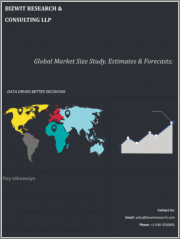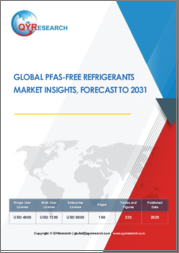
|
시장보고서
상품코드
1355664
세계의 자연 냉매 시장 규모 조사 및 예측 : 유형별, 최종 용도 산업별, 지역별 분석(2023-2030년)Global Natural Refrigerants Market Size Study & Forecast, by Type (Hydrocarbons, Ammonia, Carbon Dioxide), by End-Use Industry (Industrial, Commercial, Domestic), and Regional Analysis, 2023-2030 |
||||||
세계의 자연 냉매 시장은 2022년에 약 15억 달러로 평가되며, 예측 기간인 2023- 2030년에는 6.5% 이상의 건전한 성장률로 성장할 것으로 예측되고 있습니다.
천연 냉매는 냉동 및 공조 시스템의 냉각제로 사용되는 물질입니다. 천연 냉매의 제조에는 생화학적 기술이 사용됩니다. 기본적인 천연 냉매에는 암모니아, 이산화탄소(CO2), 탄화수소 등이 있습니다. 환경에 대한 관심이 높아지면서 잠재적인 수요가 생겨나고 있습니다. 이들 냉매는 천연자원으로 만들어지기 때문에 기존 냉매보다 환경 친화적입니다. 인공 냉매는 오존층을 심각하게 파괴하고 지구 온난화를 가속화합니다. 따라서 하이드로플루오로카본(HFC), 하이드로클로로플루오로카본(HCFC), 클로로플루오로카본(CFC)의 이상적인 대체품으로 효율적으로 사용되고 있습니다. 친환경 냉매, 낮은 환경 영향, 지구 온난화의 영향, 냉동 및 공조 용도에 대한 수요 증가에 대한 인식이 높아지면서 세계 시장 성장에 영향을 미치고 있습니다.
또한 합성 냉매 사용을 배제하고 온실가스 배출을 통제하기 위한 정부의 구상과 프로토콜이 세계에서 증가하고 있는 것도 시장 성장의 촉매제 역할을 하고 있습니다. 예를 들어 2021년 8월 인도 연방 내각은 2016년 10월 르완다 키갈리에서 열린 제28차 몬트리올 의정서 당사국 총회에서 인도의 수소불화탄소(HFC) 단계적 감축을 위해 오존층 파괴 물질에 관한 몬트리올 의정서의 HFC의 전면 폐지는 온실가스 배출을 막고 기후 변화를 막는 데 도움이 될 것으로 기대되며, 국민들에게도 유리합니다. 이와 같이 앞서 언급한 요인들은 추정 기간 중 자연 냉매 시장의 성장을 가속하고 있습니다. 또한 친환경 냉방 분야의 기술 발전과 정부 구상 증가는 예측 기간 중 다양한 유리한 기회를 제공합니다. 그러나 높은 초기 자본 비용 요구 사항과 HVAC 계약자 및 기술자의 교육 및 인식 부족은 2023-2030년까지 예측 기간 중 시장 성장에 어려움을 겪고 있습니다.
세계의 자연 냉매 시장 조사에서 고려된 주요 지역은 아시아태평양, 북미, 유럽, 라틴아메리카, 중동 및 아프리카입니다. 유럽은 환경 문제와 배출 규제 강화, 에어컨 및 냉동 시스템에 대한 수요가 증가함에 따라 2022년 시장을 장악했습니다. 반면 아시아태평양은 예측 기간 중 가장 높은 CAGR로 성장할 것으로 예상됩니다. 온실가스 배출 억제에 대한 관심이 높아지고 유해한 하이드로플루오로카본 및 하이드로클로로플루오로카본 냉매를 단계적으로 폐지하기 위한 엄격한 정부 규제가 부과되면서 이 지역 전체 시장 수요를 크게 촉진하고 있습니다.
이 연구의 목적은 최근 수년간 다양한 부문과 국가 시장 규모를 정의하고 향후 수년간의 가치를 예측하는 것입니다. 이 보고서는 조사 대상 국가의 산업의 질적/양적 측면을 포함하도록 설계되었습니다.
또한 시장의 미래 성장을 규정하는 촉진요인과 과제와 같은 중요한 측면에 대한 자세한 정보도 제공합니다. 또한 주요 기업의 경쟁 구도와 제품 제공에 대한 상세한 분석과 함께 이해관계자들이 투자할 수 있는 미시적 시장에서의 잠재적 기회도 포함합니다.
목차
제1장 주요 요약
제2장 세계의 자연 냉매 시장의 정의와 범위
- 조사 목적
- 시장의 정의와 범위
- 산업의 진화
- 조사 범위
- 조사 대상년
- 통화 환산율
제3장 세계의 자연 냉매 시장 역학
- 자연 냉매 시장의 영향 분석(2020-2030년)
- 시장 촉진요인
- 친환경 냉매에 대한 의식의 향상
- 온실가스 배출을 억제하기 위한 정부 구상 및 프로토콜의 증가
- 시장이 해결해야 할 과제
- 높은 초기 자본비용
- HVAC 계약업체나 기술자 교육·인식의 부족
- 시장 기회
- 에코 냉방의 기술적 진보의 급증
- 정부 구상의 증가
- 시장 촉진요인
제4장 세계의 자연 냉매 시장 산업 분석
- Porter's 5 Force 모델
- 공급 기업의 교섭력
- 구매자의 교섭력
- 신규 진출업체의 위협
- 대체품의 위협
- 경쟁 기업간 경쟁 관계
- Porter's 5 Force 영향 분석
- PEST 분석
- 정치
- 경제
- 사회
- 기술
- 환경
- 법률
- 주요 투자 기회
- 주요 성공 전략
- COVID-19 영향 분석
- 파괴적 동향
- 업계 전문가의 시점
- 애널리스트의 결론·제안
제5장 세계의 자연 냉매 시장 : 유형별
- 시장 스냅숏
- 세계의 자연 냉매 시장 : 유형별, 실적·잠재력 분석
- 세계의 자연 냉매 시장 : 유형별, 추정·예측, 2020-2030년
- 세계의 자연 냉매 시장, 하위 부문별 분석
- 탄화수소
- 암모니아
- 이산화탄소
제6장 세계의 자연 냉매 시장 : 최종 용도 산업별
- 시장 스냅숏
- 세계의 자연 냉매 시장 : 최종 용도 산업별, 실적·잠재력 분석
- 세계의 자연 냉매 시장 : 최종 용도 산업별, 추정·예측, 2020-2030년
- 세계의 자연 냉매 시장, 하위 부문 분석
- 산업용
- 상업용
- 가정용
제7장 세계의 자연 냉매 시장 : 지역별 분석
- 주요 국가
- 주요 신흥 국가
- 세계의 자연 냉매 시장 : 지역별 시장 스냅숏
- 북미
- 미국
- 유형별, 추정·예측, 2020-2030년
- 최종 용도 산업, 추정·예측, 2020-2030년
- 캐나다
- 미국
- 유럽 자연 냉매 시장 스냅숏
- 영국
- 독일
- 프랑스
- 스페인
- 이탈리아
- 기타 유럽
- 아시아태평양 자연 냉매 시장 스냅숏
- 중국
- 인도
- 일본
- 호주
- 한국
- 기타 아시아태평양
- 라틴아메리카 자연 냉매 시장 스냅숏
- 브라질
- 멕시코
- 중동 및 아프리카
- 사우디아라비아
- 남아프리카공화국
- 기타 중동 및 아프리카
제8장 경쟁 정보
- 주요 기업의 SWOT 분석
- 주요 시장 전략
- 기업 개요
- Air Liquide(프랑스)
- 주요 정보
- 개요
- 재무(데이터의 가용성에 따름)
- 제품 개요
- 최근 동향
- Linde plc(아일랜드)
- A-Gas International Ltd.(영국)
- HyChill Australia Pty Ltd(호주)
- engas Australasia(호주)
- Tazzetti S.p.A.(이탈리아)
- Shandong Yuean Chemical Industry Co., Ltd.(중국)
- AGC Inc.(일본)
- Puyang Zhongwei Fine Chemical Co., Ltd.(중국)
- Danfoss(덴마크)
- Air Liquide(프랑스)
제9장 조사 프로세스
- 조사 프로세스
- 데이터 광업
- 분석
- 시장 추정
- 검증
- 출판
- 조사 속성
- 조사 전제조건
Global Natural Refrigerants Market is valued at approximately USD 1.50 billion in 2022 and is anticipated to grow with a healthy growth rate of more than 6.5% over the forecast period 2023-2030. Natural refrigerants are substances that are used as cooling agents in refrigeration and air conditioning systems. Biochemical techniques are used to produce natural refrigerants. Some basic natural refrigerants are ammonia, carbon dioxide (CO2), and hydrocarbons. Potential demand for the product has been generated by growing concerns about the environment. These refrigerants are more ecologically friendly than traditional refrigerants because they are made from natural resources. Artificial refrigerants deplete the ozone layer severely and accelerate global warming. It is efficiently used as an ideal substitute for hydrofluorocarbons (HFC), hydrochlorofluorocarbons (HCFC), and chlorofluorocarbons (CFC) because the product is more effective. The growing awareness regarding environment-friendly refrigerants, low environmental impact, effects of global warming, and surging demand for refrigeration and air-conditioning applications are the factors that are attributing to the market growth across the globe.
In addition, the rising number of government initiatives and protocols to control greenhouse gas emissions, along with eliminating the utilization of synthetic refrigerants is acting as a catalyzing factor for market growth across the globe. For instance, in August 2021, The Union Cabinet of India has given its consent for the indorsement of the Kigali Amendment to the Montreal Protocol on Substances that Deplete the Ozone Layer for the phase down of Hydroflurocarbons (HFCs) by India, implemented by the Parties to the Montreal Protocol on October 2016 at 28th Meeting of the Parties to the Montreal Protocol held at Kigali, Rwanda. The elimination of HFCs is anticipated to stop the release of greenhouse gases, which helps in preventing climate change and is advantageous to the public. Thus, these aforementioned factors are propelling the growth of the Natural Refrigerants Market during the estimated period. Moreover, the surging technological advancements in green cooling, as well as the increasing number of government initiatives present various lucrative opportunities over the forecast years. However, the higher initial capital cost requirement and the lack of education and awareness of HVAC contractors and technicians are challenging the market growth throughout the forecast period of 2023-2030.
The key regions considered for the Global Natural Refrigerants Market study include: Asia Pacific, North America, Europe, Latin America, and Middle East & Africa. Europe dominated the market in 2022 owing to the rising environmental concerns and emission regulations, as well as strong demand for air conditioners and refrigerating systems. Whereas, Asia Pacific is expected to grow at the highest CAGR over the forecast years. The growing emphasis on controlling greenhouse gas emissions, and the imposition of stringent government regulations to phase out harmful hydrofluorocarbon and hydro-chlorofluorocarbon refrigerants are significantly propelling the market demand across the region.
Major market players included in this report are:
- Air Liquide (France)
- Linde plc (Ireland)
- A-Gas International Ltd. (U.K.)
- HyChill Australia Pty Ltd (Australia)
- engas Australasia (Australia)
- Tazzetti S.p.A. (Italy)
- Shandong Yuean Chemical Industry Co., Ltd. (China)
- AGC Inc. (Japan)
- Puyang Zhongwei Fine Chemical Co., Ltd. (China)
- Danfoss (Denmark)
Recent Developments in the Market:
- In March 2023, Danfoss announced that the company acquired BOCK GmbH, a producer of low-GWP and carbon dioxide compressors. For natural refrigerants such as hydrocarbons, CO2 (R744), and other low-GWP refrigerants, BOCK GmbH has one of the broadest product ranges of compressors. The agreement aims to accelerate the shift to natural and low-GWP refrigerants worldwide and increase energy efficiency.
- In February 2023, Linde signed a long-term deal and made an investment of about USD 1.8 billion in order to deliver clean hydrogen and nitrogen to OCI's new, massive blue ammonia factory in Beaumont, Texas. The Beaumont plant is focusing on expanding and solidifying the industry's premier blue ammonia and clean fuels platform.
Global Natural Refrigerants Market Report Scope:
- Historical Data: 2020 - 2021
- Base Year for Estimation: 2022
- Forecast period: 2023-2030
- Report Coverage: Revenue forecast, Company Ranking, Competitive Landscape, Growth factors, and Trends
- Segments Covered: Type, End-Use Industry, Region
- Regional Scope: North America; Europe; Asia Pacific; Latin America; Middle East & Africa
- Customization Scope: Free report customization (equivalent up to 8 analyst's working hours) with purchase. Addition or alteration to country, regional & segment scope*
The objective of the study is to define market sizes of different segments & countries in recent years and to forecast the values to the coming years. The report is designed to incorporate both qualitative and quantitative aspects of the industry within countries involved in the study.
The report also caters detailed information about the crucial aspects such as driving factors & challenges which will define the future growth of the market. Additionally, it also incorporates potential opportunities in micro markets for stakeholders to invest along with the detailed analysis of competitive landscape and product offerings of key players. The detailed segments and sub-segment of the market are explained below:
By Type:
- Hydrocarbons
- Ammonia
- Carbon Dioxide
By End-Use Industry:
- Industrial
- Commercial
- Domestic
By Region:
- North America
- U.S.
- Canada
- Europe
- UK
- Germany
- France
- Spain
- Italy
- ROE
- Asia Pacific
- China
- India
- Japan
- Australia
- South Korea
- RoAPAC
- Latin America
- Brazil
- Mexico
- Middle East & Africa
- Saudi Arabia
- South Africa
- Rest of Middle East & Africa
Table of Contents
Chapter 1. Executive Summary
- 1.1. Market Snapshot
- 1.2. Global & Segmental Market Estimates & Forecasts, 2020-2030 (USD Billion)
- 1.2.1. Natural Refrigerants Market, by Region, 2020-2030 (USD Billion)
- 1.2.2. Natural Refrigerants Market, by Type, 2020-2030 (USD Billion)
- 1.2.3. Natural Refrigerants Market, by End-Use Industry, 2020-2030 (USD Billion)
- 1.3. Key Trends
- 1.4. Estimation Methodology
- 1.5. Research Assumption
Chapter 2. Global Natural Refrigerants Market Definition and Scope
- 2.1. Objective of the Study
- 2.2. Market Definition & Scope
- 2.2.1. Industry Evolution
- 2.2.2. Scope of the Study
- 2.3. Years Considered for the Study
- 2.4. Currency Conversion Rates
Chapter 3. Global Natural Refrigerants Market Dynamics
- 3.1. Natural Refrigerants Market Impact Analysis (2020-2030)
- 3.1.1. Market Drivers
- 3.1.1.1. Growing awareness regarding environment-friendly refrigerants
- 3.1.1.2. Rising number of government initiatives and protocols to control greenhouse gas emissions
- 3.1.2. Market Challenges
- 3.1.2.1. Higher initial capital cost requirement
- 3.1.2.2. Lack of education and awareness among HVAC contractors and technicians
- 3.1.3. Market Opportunities
- 3.1.3.1. Surging technological advancements in green cooling
- 3.1.3.2. Increasing number of government initiatives
- 3.1.1. Market Drivers
Chapter 4. Global Natural Refrigerants Market Industry Analysis
- 4.1. Porter's 5 Force Model
- 4.1.1. Bargaining Power of Suppliers
- 4.1.2. Bargaining Power of Buyers
- 4.1.3. Threat of New Entrants
- 4.1.4. Threat of Substitutes
- 4.1.5. Competitive Rivalry
- 4.2. Porter's 5 Force Impact Analysis
- 4.3. PEST Analysis
- 4.3.1. Political
- 4.3.2. Economical
- 4.3.3. Social
- 4.3.4. Technological
- 4.3.5. Environmental
- 4.3.6. Legal
- 4.4. Top investment opportunity
- 4.5. Top winning strategies
- 4.6. COVID-19 Impact Analysis
- 4.7. Disruptive Trends
- 4.8. Industry Expert Perspective
- 4.9. Analyst Recommendation & Conclusion
Chapter 5. Global Natural Refrigerants Market, by Type
- 5.1. Market Snapshot
- 5.2. Global Natural Refrigerants Market by Type, Performance - Potential Analysis
- 5.3. Global Natural Refrigerants Market Estimates & Forecasts by Type 2020-2030 (USD Billion)
- 5.4. Natural Refrigerants Market, Sub Segment Analysis
- 5.4.1. Hydrocarbons
- 5.4.2. Ammonia
- 5.4.3. Carbon Dioxide
Chapter 6. Global Natural Refrigerants Market, by End-Use Industry
- 6.1. Market Snapshot
- 6.2. Global Natural Refrigerants Market by End-Use Industry, Performance - Potential Analysis
- 6.3. Global Natural Refrigerants Market Estimates & Forecasts by End-Use Industry 2020-2030 (USD Billion)
- 6.4. Natural Refrigerants Market, Sub Segment Analysis
- 6.4.1. Industrial
- 6.4.2. Commercial
- 6.4.3. Domestic
Chapter 7. Global Natural Refrigerants Market, Regional Analysis
- 7.1. Top Leading Countries
- 7.2. Top Emerging Countries
- 7.3. Natural Refrigerants Market, Regional Market Snapshot
- 7.4. North America Natural Refrigerants Market
- 7.4.1. U.S. Natural Refrigerants Market
- 7.4.1.1. Type breakdown estimates & forecasts, 2020-2030
- 7.4.1.2. End-Use Industry breakdown estimates & forecasts, 2020-2030
- 7.4.2. Canada Natural Refrigerants Market
- 7.4.1. U.S. Natural Refrigerants Market
- 7.5. Europe Natural Refrigerants Market Snapshot
- 7.5.1. U.K. Natural Refrigerants Market
- 7.5.2. Germany Natural Refrigerants Market
- 7.5.3. France Natural Refrigerants Market
- 7.5.4. Spain Natural Refrigerants Market
- 7.5.5. Italy Natural Refrigerants Market
- 7.5.6. Rest of Europe Natural Refrigerants Market
- 7.6. Asia-Pacific Natural Refrigerants Market Snapshot
- 7.6.1. China Natural Refrigerants Market
- 7.6.2. India Natural Refrigerants Market
- 7.6.3. Japan Natural Refrigerants Market
- 7.6.4. Australia Natural Refrigerants Market
- 7.6.5. South Korea Natural Refrigerants Market
- 7.6.6. Rest of Asia Pacific Natural Refrigerants Market
- 7.7. Latin America Natural Refrigerants Market Snapshot
- 7.7.1. Brazil Natural Refrigerants Market
- 7.7.2. Mexico Natural Refrigerants Market
- 7.8. Middle East & Africa Natural Refrigerants Market
- 7.8.1. Saudi Arabia Natural Refrigerants Market
- 7.8.2. South Africa Natural Refrigerants Market
- 7.8.3. Rest of Middle East & Africa Natural Refrigerants Market
Chapter 8. Competitive Intelligence
- 8.1. Key Company SWOT Analysis
- 8.1.1. Company 1
- 8.1.2. Company 2
- 8.1.3. Company 3
- 8.2. Top Market Strategies
- 8.3. Company Profiles
- 8.3.1. Air Liquide (France)
- 8.3.1.1. Key Information
- 8.3.1.2. Overview
- 8.3.1.3. Financial (Subject to Data Availability)
- 8.3.1.4. Product Summary
- 8.3.1.5. Recent Developments
- 8.3.2. Linde plc (Ireland)
- 8.3.3. A-Gas International Ltd. (U.K.)
- 8.3.4. HyChill Australia Pty Ltd (Australia)
- 8.3.5. engas Australasia (Australia)
- 8.3.6. Tazzetti S.p.A. (Italy)
- 8.3.7. Shandong Yuean Chemical Industry Co., Ltd. (China)
- 8.3.8. AGC Inc. (Japan)
- 8.3.9. Puyang Zhongwei Fine Chemical Co., Ltd. (China)
- 8.3.10. Danfoss (Denmark)
- 8.3.1. Air Liquide (France)
Chapter 9. Research Process
- 9.1. Research Process
- 9.1.1. Data Mining
- 9.1.2. Analysis
- 9.1.3. Market Estimation
- 9.1.4. Validation
- 9.1.5. Publishing
- 9.2. Research Attributes
- 9.3. Research Assumption


















